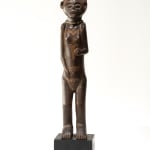Anonymous artist
Origin: Angola
height 17 3/8 in
Further images
Within the corpus of African art, male Chokwe statues depicting the cultural hero Chibinda Ilunga are among the most celebrated ancestor statues. Much rarer are female Chokwe figures. Especially when paired with the mythical hunter Chibinda Ilunga, female statues are thought to represent his wife Lweji, or one of his other highly ranking wives. It has also been suggested that these statues commemorate individual female dignitaries as successors to the founding sovereign. A third interpretation is that the female subject may be the Queen Mother, embodying the matrilineal succession of power within Chokwe lineages. Whether which female ancestor exactly the statue represents or not, the image signals the importance of the female line and female power within Chokwe society. The primordial significance of the female as mother and responsible for the foundation and perpetuation of the culture is particularly essential to the Chokwe, as they organized themselves in matrilineal lineages. Besides emphasizing the importance of matrilineage, it is difficult to know the precise function of these figures. Chokwe chiefs sometimes displayed such wooden figure inside their homes as evidence of their wealth and power. This figure may also have been owned by a Chokwe diviner who sought the insight of such an important female ancestor. While this statue’s body is rather static, except for the hand gesture, our focus is drawn to the finely sculpted head. Indeed, the face was the focus for ancient symbols of aristocratic beauty amongst the Chokwe. The lenticular eyes are set in large, arched surrounds, a typical Chokwe stylistic feature; they meet at the top of the delicate small nose. Above the incised arched eyebrows, we find the typical cingelyengelye motif which is sometimes claimed to be an old Portuguese catholic influence. The closed slightly protruding mouth is thin and narrow. The large ears are jutting, its lobes pierced to attach earrings. A wide diadem runs over the forehead. The imposing, elaborate coiffure, or wig is divided in three parts by a wide recessed separation. The front two sections are crosshatched whereas the rounded back of the head is decorated with parallel incised lines. The wide neck is foreshortened and holds a necklace of small, imported glass beads. Wavelike scarification patterns decorated the lower torso, shoulder blades and lower back, while other motifs grace the buttocks and middle and upper torso. Such scarification patterns were a clear marker of identity, reserved for Chokwe women, and together with the complex coiffure a celebrated element of beauty.
Provenance
Private Collection, 1971
Parke Bernet Galleries, New York, 23 October 1971, lot 155.
Egon Guenther, Johannesburg
Sotheby’s, New York, 18 November 2000, lot 151.
Lucien Van de Velde, Antwerp, 2000
Cees Van Strien CollectionBy descent through family, 2022
Exhibitions
Central Africa, Lucien Van de Velde, Anvers, 8-9 October 2011Publications
Antiquairs Antwerpen, Antwerp, 2005 (flyer)
Antiquairs Antwerpen, Antwerp, 2006 (agenda)
Van de Velde, Lucien, Central Africa, Antwerp, 2011









